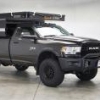
delete
#21

Posted 25 June 2021 - 07:13 AM
I didn’t mean to be critical of using larger wire. I agree if there’s a question that you might increase the size of the charger above 30 amps in the future that’s a good reason to go bigger.
Jon R
2021 Grandby Slide-in Front Dinette
2021 GMC 3500HD CC LB SRW Gas
1993 Chevrolet K2500 Ext Cab LB
#22

Posted 25 June 2021 - 07:24 AM
Hi Vic,Within limits, rando. For example, if you have to adjust the "engine on detection" to less than ... 12.7 volts to overcome the voltage drop, then how will the Orion know that the engine is NOT running when you turn off the truck? The standby voltage of the fully charged AGM starting battery is 12.65 or so...
In such a case I would think you would have to wire in the voltage detect wire, or use the remote switch, to manually enable the Orion.
At least, that is my theory...
Victron now uses an engine running detection scheme where, when the voltage in at the charger dips below something like 12.7, the charger will cut off charging every two minutes to check the open circuit voltage to see if the engine is still running. This allows you to avoid running an additional wire, but cycles your charging off every two minutes. It’s described in the manual available on line. I think they added that feature in the last year or two.
My nearly 30 foot run of 6 awg Ancor marine cable on my new truck and camper is sufficient to maintain the voltage above 13.5 volts at the charger input in the camper battery compartment when it’s drawing 35 amps, avoiding that cycling. If one used 8 or 10 gage wire they’d likely be in that cycling voltage range.
(Edited voltage after double checking readings)
Edited by Jon R, 26 June 2021 - 02:07 AM.
Jon R
2021 Grandby Slide-in Front Dinette
2021 GMC 3500HD CC LB SRW Gas
1993 Chevrolet K2500 Ext Cab LB
#23

Posted 25 June 2021 - 07:47 AM
Hi Vic,
Victron now uses an engine running detection scheme that, when the voltage in at the charger drips below something like 12.7, the charger will cut off charging every two minutes to check the open circuit voltage to see if the engine is still running. This allows you to avoid running an additional wire, but cycles your charging off every two minutes. It’s described in the manual available on line. I think they added that feature in the last year or two.
My nearly 30 foot run of 6 awg Ancor marine cable on my new truck and camper is sufficient to maintain the voltage above 14 volts at the charger input in the camper battery compartment when it’s drawing 35 amps, avoiding that cycling. If one used 8 or 10 gage wire they’d likely be in that cycling voltage range.
Whoa, that's cool. I got my Orion when these were very new. Out of the box, the charge detection settings didn't work at all. Luckily, a software rev came out a day after I installed mine, and voila, it worked! So, I am super stoked that they keep improving these things. What you describe is super useful, and good to know.
2012 ATC Puma Shell build - https://www.wanderth...012-puma-build/
Power considerations thread - https://www.wanderth...e-power-scotty/
Building out an electrical system - So, you want to setup a good electrical system in your camper? - Electrical, Charging, Solar, Batteries and Generators - Wander the West
#24

Posted 25 June 2021 - 02:21 PM
Whoa, that's cool. I got my Orion when these were very new. Out of the box, the charge detection settings didn't work at all. Luckily, a software rev came out a day after I installed mine, and voila, it worked! So, I am super stoked that they keep improving these things. What you describe is super useful, and good to know.
==================================================================================
Good point Vic....One of the reasons my 110, solar and DC/DC chargers [and BMV712] are Victron; so that as updates come out, I can update the devices with my "Victron Connect" Bluetooth from my phone.
Edited by Wallowa, 25 June 2021 - 02:22 PM.
#25

Posted 25 June 2021 - 02:27 PM
Hi Rich,
I didn’t mean to be critical of using larger wire. I agree if there’s a question that you might increase the size of the charger above 30 amps in the future that’s a good reason to go bigger.
Hey John, no, I didn't take it as criticism at all. Happy to hear that the 6 AWG worked out for you as you had intended. - Rich
- 2001 Cummins 2500 quad cab 4x4 turbo diesel; NV4500 5-spd manual transmission; CM aluminum flatbed, '20 FWC Hawk shell - hybrid buildout. https://ian-frese-of...r.blogspot.com/
- 2004 Jeep TJ - Rubicon
#26

Posted 26 June 2021 - 04:11 PM
Within limits, rando. For example, if you have to adjust the "engine on detection" to less than ... 12.7 volts to overcome the voltage drop, then how will the Orion know that the engine is NOT running when you turn off the truck? The standby voltage of the fully charged AGM starting battery is 12.65 or so...
In such a case I would think you would have to wire in the voltage detect wire, or use the remote switch, to manually enable the Orion.
At least, that is my theory...
Victron did think of that. There is hysteresis between the 'on' and 'off' voltages as well as a smart mode, which momentarily disables the charge current to check and see what the truck battery/alternator voltage is without any current flowing and loss in the wire. For example, say your alternator puts out 13.7V and you have a 1V drop in the wiring - set the 'on' detection at 13.6V and the off detection at 12.5V. When the truck starts, the truck battery quickly goes up to 13.7V, but at that point there is no current flowing to the DC-DC charger, so it also sees 13.7V and turns on. Once it is on, there is 1V drop so the DC-DC is now seeing 12.7 on the input, which is still high enough to stay on. You stop the truck, the battery quickly drops to its resting voltage of 12.8V, which means the DC-DC is seeing 11.8V after the 1V drop which is below 12.5V, so it shuts down.
I am certainly not suggesting that there is anything wrong with running large wire from the alternator to the DC-DC charger, if you have done that, or it easy to do, then that is the ideal situation. In that case you may not need DC-DC charge as the house battery may get a better charge directly from the alternator.
But one of the main reasons to install a DC-DC charger is to compensate for voltage drop on the wiring to the camper, which is why you generally don't get a great charge to the house battery from the alternator with the stock wiring. Putting in a DC-DC charger is often cheaper and easier than re-wiring the truck and camper with larger wire. A 20A DC-DC converter will likely work on the stock 10AWG wire, and is within specifications. A 30A DC-DC would be marginal, and in that case you would probably want to at least upgrade the cable from the alternator -> camper, even if you don't want to disassemble the cabinets to get to the 10AWG inside the camper. This is what I have done, and while I am using a home-made DC-DC charger not an Orion, it works well.
Again, I am not trying to argue that you shouldn't use larger wire. All I am saying is that you may not need to use larger wiring - the DC-DC will compensate for the voltage drop in the wire and boost the voltage (and current) to the house battery.
2016 Fleet Flatbed
2016 Toyota Tacoma
#27

Posted 26 June 2021 - 04:22 PM
Rando...thanks for the clear description of on/off triggers and I do love it when you talk dirty...."hysteresis"... ![]()
Phil
#28

Posted 30 June 2021 - 06:40 AM
Victron did think of that. There is hysteresis between the 'on' and 'off' voltages as well as a smart mode, which momentarily disables the charge current to check and see what the truck battery/alternator voltage is without any current flowing and loss in the wire. For example, say your alternator puts out 13.7V and you have a 1V drop in the wiring - set the 'on' detection at 13.6V and the off detection at 12.5V. When the truck starts, the truck battery quickly goes up to 13.7V, but at that point there is no current flowing to the DC-DC charger, so it also sees 13.7V and turns on. Once it is on, there is 1V drop so the DC-DC is now seeing 12.7 on the input, which is still high enough to stay on. You stop the truck, the battery quickly drops to its resting voltage of 12.8V, which means the DC-DC is seeing 11.8V after the 1V drop which is below 12.5V, so it shuts down.
I am certainly not suggesting that there is anything wrong with running large wire from the alternator to the DC-DC charger, if you have done that, or it easy to do, then that is the ideal situation. In that case you may not need DC-DC charge as the house battery may get a better charge directly from the alternator.
But one of the main reasons to install a DC-DC charger is to compensate for voltage drop on the wiring to the camper, which is why you generally don't get a great charge to the house battery from the alternator with the stock wiring. Putting in a DC-DC charger is often cheaper and easier than re-wiring the truck and camper with larger wire. A 20A DC-DC converter will likely work on the stock 10AWG wire, and is within specifications. A 30A DC-DC would be marginal, and in that case you would probably want to at least upgrade the cable from the alternator -> camper, even if you don't want to disassemble the cabinets to get to the 10AWG inside the camper. This is what I have done, and while I am using a home-made DC-DC charger not an Orion, it works well.
Again, I am not trying to argue that you shouldn't use larger wire. All I am saying is that you may not need to use larger wiring - the DC-DC will compensate for the voltage drop in the wire and boost the voltage (and current) to the house battery.
Understood. The charge detection stuff does work (my Orion shipped with really old firmware so I got to see the "old" version of this) but not much charging was happening with the on/off cycles. The new firmware changed a bunch of settings and it all worked great (with 2g wire!) except that it constantly overheated. A loud 75cfm fan is now in place to cool the unit, and it works as planned.
And I agree that the Orion will work better than an ACR/Isolator over the 10g wire typically used.
2012 ATC Puma Shell build - https://www.wanderth...012-puma-build/
Power considerations thread - https://www.wanderth...e-power-scotty/
Building out an electrical system - So, you want to setup a good electrical system in your camper? - Electrical, Charging, Solar, Batteries and Generators - Wander the West
0 user(s) are reading this topic
0 members, 0 guests, 0 anonymous users













